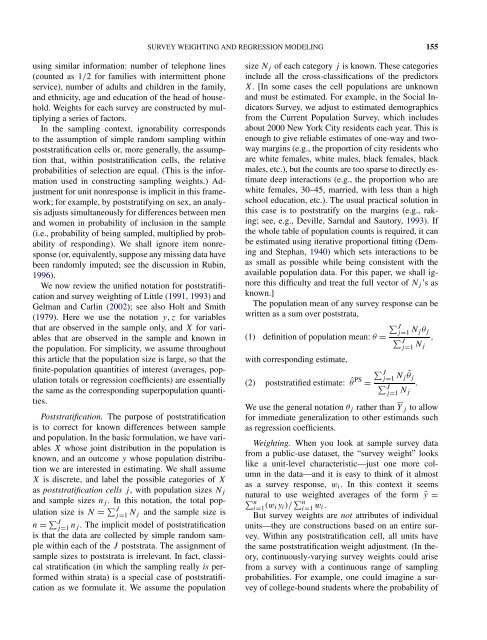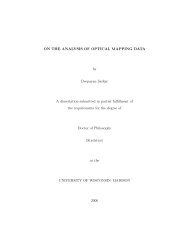Struggles with Survey Weighting and Regression Modeling paper
Struggles with Survey Weighting and Regression Modeling paper
Struggles with Survey Weighting and Regression Modeling paper
Create successful ePaper yourself
Turn your PDF publications into a flip-book with our unique Google optimized e-Paper software.
SURVEY WEIGHTING AND REGRESSION MODELING 155<br />
using similar information: number of telephone lines<br />
(counted as 1/2 for families <strong>with</strong> intermittent phone<br />
service), number of adults <strong>and</strong> children in the family,<br />
<strong>and</strong> ethnicity, age <strong>and</strong> education of the head of household.<br />
Weights for each survey are constructed by multiplying<br />
a series of factors.<br />
In the sampling context, ignorability corresponds<br />
to the assumption of simple r<strong>and</strong>om sampling <strong>with</strong>in<br />
poststratification cells or, more generally, the assumption<br />
that, <strong>with</strong>in poststratification cells, the relative<br />
probabilities of selection are equal. (This is the information<br />
used in constructing sampling weights.) Adjustment<br />
for unit nonresponse is implicit in this framework;<br />
for example, by poststratifying on sex, an analysis<br />
adjusts simultaneously for differences between men<br />
<strong>and</strong> women in probability of inclusion in the sample<br />
(i.e., probability of being sampled, multiplied by probability<br />
of responding). We shall ignore item nonresponse<br />
(or, equivalently, suppose any missing data have<br />
been r<strong>and</strong>omly imputed; see the discussion in Rubin,<br />
1996).<br />
We now review the unified notation for poststratification<br />
<strong>and</strong> survey weighting of Little (1991, 1993)<strong>and</strong><br />
Gelman <strong>and</strong> Carlin (2002); see also Holt <strong>and</strong> Smith<br />
(1979). Here we use the notation y,z for variables<br />
that are observed in the sample only, <strong>and</strong> X for variables<br />
that are observed in the sample <strong>and</strong> known in<br />
the population. For simplicity, we assume throughout<br />
this article that the population size is large, so that the<br />
finite-population quantities of interest (averages, population<br />
totals or regression coefficients) are essentially<br />
the same as the corresponding superpopulation quantities.<br />
Poststratification. The purpose of poststratification<br />
is to correct for known differences between sample<br />
<strong>and</strong> population. In the basic formulation, we have variables<br />
X whose joint distribution in the population is<br />
known, <strong>and</strong> an outcome y whose population distribution<br />
we are interested in estimating. We shall assume<br />
X is discrete, <strong>and</strong> label the possible categories of X<br />
as poststratification cells j, <strong>with</strong> population sizes N j<br />
<strong>and</strong> sample sizes n j . In this notation, the total population<br />
size is N = ∑ J<br />
j=1 N j <strong>and</strong> the sample size is<br />
n = ∑ J<br />
j=1 n j . The implicit model of poststratification<br />
is that the data are collected by simple r<strong>and</strong>om sample<br />
<strong>with</strong>in each of the J poststrata. The assignment of<br />
sample sizes to poststrata is irrelevant. In fact, classical<br />
stratification (in which the sampling really is performed<br />
<strong>with</strong>in strata) is a special case of poststratification<br />
as we formulate it. We assume the population<br />
size N j of each category j is known. These categories<br />
include all the cross-classifications of the predictors<br />
X. [In some cases the cell populations are unknown<br />
<strong>and</strong> must be estimated. For example, in the Social Indicators<br />
<strong>Survey</strong>, we adjust to estimated demographics<br />
from the Current Population <strong>Survey</strong>, which includes<br />
about 2000 New York City residents each year. This is<br />
enough to give reliable estimates of one-way <strong>and</strong> twoway<br />
margins (e.g., the proportion of city residents who<br />
are white females, white males, black females, black<br />
males, etc.), but the counts are too sparse to directly estimate<br />
deep interactions (e.g., the proportion who are<br />
white females, 30–45, married, <strong>with</strong> less than a high<br />
school education, etc.). The usual practical solution in<br />
this case is to poststratify on the margins (e.g., raking;<br />
see, e.g., Deville, Sarndal <strong>and</strong> Sautory, 1993). If<br />
the whole table of population counts is required, it can<br />
be estimated using iterative proportional fitting (Deming<br />
<strong>and</strong> Stephan, 1940) which sets interactions to be<br />
as small as possible while being consistent <strong>with</strong> the<br />
available population data. For this <strong>paper</strong>, we shall ignore<br />
this difficulty <strong>and</strong> treat the full vector of N j ’s as<br />
known.]<br />
The population mean of any survey response can be<br />
written as a sum over poststrata,<br />
∑ Jj=1<br />
N j θ j<br />
(1) definition of population mean: θ = ∑ Jj=1<br />
,<br />
N j<br />
<strong>with</strong> corresponding estimate,<br />
(2)<br />
poststratified estimate: ˆθ PS =<br />
∑ Jj=1<br />
N j ˆθ j<br />
∑ Jj=1<br />
N j<br />
.<br />
We use the general notation θ j rather than Y j to allow<br />
for immediate generalization to other estim<strong>and</strong>s such<br />
as regression coefficients.<br />
<strong>Weighting</strong>. When you look at sample survey data<br />
from a public-use dataset, the “survey weight” looks<br />
like a unit-level characteristic—just one more column<br />
in the data—<strong>and</strong> it is easy to think of it almost<br />
as a survey response, w i . In this context it seems<br />
natural to use weighted averages of the form ȳ =<br />
∑ ni=1<br />
(w i y i )/ ∑ n<br />
i=1 w i .<br />
But survey weights are not attributes of individual<br />
units—they are constructions based on an entire survey.<br />
Within any poststratification cell, all units have<br />
the same poststratification weight adjustment. (In theory,<br />
continuously-varying survey weights could arise<br />
from a survey <strong>with</strong> a continuous range of sampling<br />
probabilities. For example, one could imagine a survey<br />
of college-bound students where the probability of
















